How to Create a Public Roadmap + Tools, Examples and Best Practices

In today's fast-paced product landscape, transparency is key. And one of the most powerful ways businesses can foster transparency is through a public product roadmap. This roadmap, shared with customers and the broader public, provides a glimpse into a product's future, showcasing the strategic vision and planned improvements. But why is a public roadmap necessary, and how can you craft one effectively?
In this article, we'll explore the intricacies of public product roadmaps, their benefits, and key considerations when creating them. We'll examine the characteristics of excellent roadmaps and present public roadmap examples from successful SaaS companies.
What’s a public roadmap?
Public roadmaps serve as a tool to communicate the future direction of your product, indicating where the product is heading, the proposed timelines for new features, and updates. However, unlike internal or private roadmaps, a public product roadmap is shared externally, typically with customers, stakeholders, and the broader community interested in your product.
A public product roadmap is a strategic document that outlines the direction and vision of a product over time. It's a visual representation of the product's life cycle, including the planned stages of development, important milestones, and features set to be released. However, it's important to note that these roadmaps are usually high-level, presenting a strategic view of the future rather than detailed technical plans.
Why do you need a public roadmap?
Improving customer relations and trust
Public roadmaps are instrumental in enhancing transparency, which in turn improves customer relations and trust. By sharing your product's future vision, you allow customers to see where you're heading and understand the evolution of your product.
This transparency can help establish trust with new customers, as it indicates that the company is confident about its plans and willing to share them openly. For example, Buffer, a social media management tool, is well known for its transparent practices, including sharing its product roadmap publicly. This has fostered a strong bond of trust with their users.
Encouraging community involvement and feedback
Public roadmaps can also encourage community involvement and feedback. They offer a platform for users to submit feedback and feature requests, suggest improvements or vote on upcoming features, making them feel involved in the product's development. For instance, Trello, a popular project management app, has a public roadmap that invites customer feedback on new feature proposals.
Facilitating better internal communication and alignment
Although primarily designed for an external audience, public roadmaps can also aid in internal communication and alignment. They ensure that everyone within the organization understands the product's strategic direction, which can help in synchronizing efforts across different teams. A clear, visual roadmap can serve as a reference point and a guide for team discussions and decision-making processes.
Reducing uncertainty in product development
Public roadmaps can reduce uncertainty in product development by setting clear expectations about what's coming up. They serve as a commitment to the planned features and improvements, providing an opportunity for a product team to align their work according to the stated product vision.
What makes a good public roadmap?
An effective public roadmap is not just about presenting a list of upcoming features; it's about conveying a compelling story of your product's evolution that resonates with your current audience and even prospective customers. Here are some elements that contribute to a successful public roadmap.
Clarity: A good public roadmap is clear and easy to understand. It uses plain language and avoids technical jargon that could confuse non-technical audiences.
Transparency: Transparency goes beyond merely sharing the roadmap. It's about being honest with your plans, including uncertainties. If there's a certain feature that you're exploring but aren't sure about, it's better to communicate that upfront. Atlassian, the company behind Jira, Confluence, and Trello, is well-known for its transparent roadmaps, which include information on what's shipping, what's next, and what's in the distant future.
Strategic focus: A successful roadmap should highlight the strategic objectives behind the planned features. Instead of the roadmap items merely listing the features, it should explain why they're valuable and how they align with the overall product strategy and company mission.
Flexibility: A roadmap is a dynamic document that evolves with your product. A good public roadmap reflects this adaptability, providing room for changes and adjustments based on user feedback and market dynamics.
Engagement: Lastly, a good public roadmap encourages user engagement. It's not just a static document but a communication tool that invites feedback and discussions. Some companies, like Canva, allow users to vote on upcoming features and provide suggestions, creating a sense of shared ownership and collaboration.
Five amazing public roadmap examples for SaaS companies
Public product roadmaps come in all shapes and sizes. Each one is unique, mirroring the specific needs, culture, and product strategy of the organization. Let's explore five of them:
Bettermode
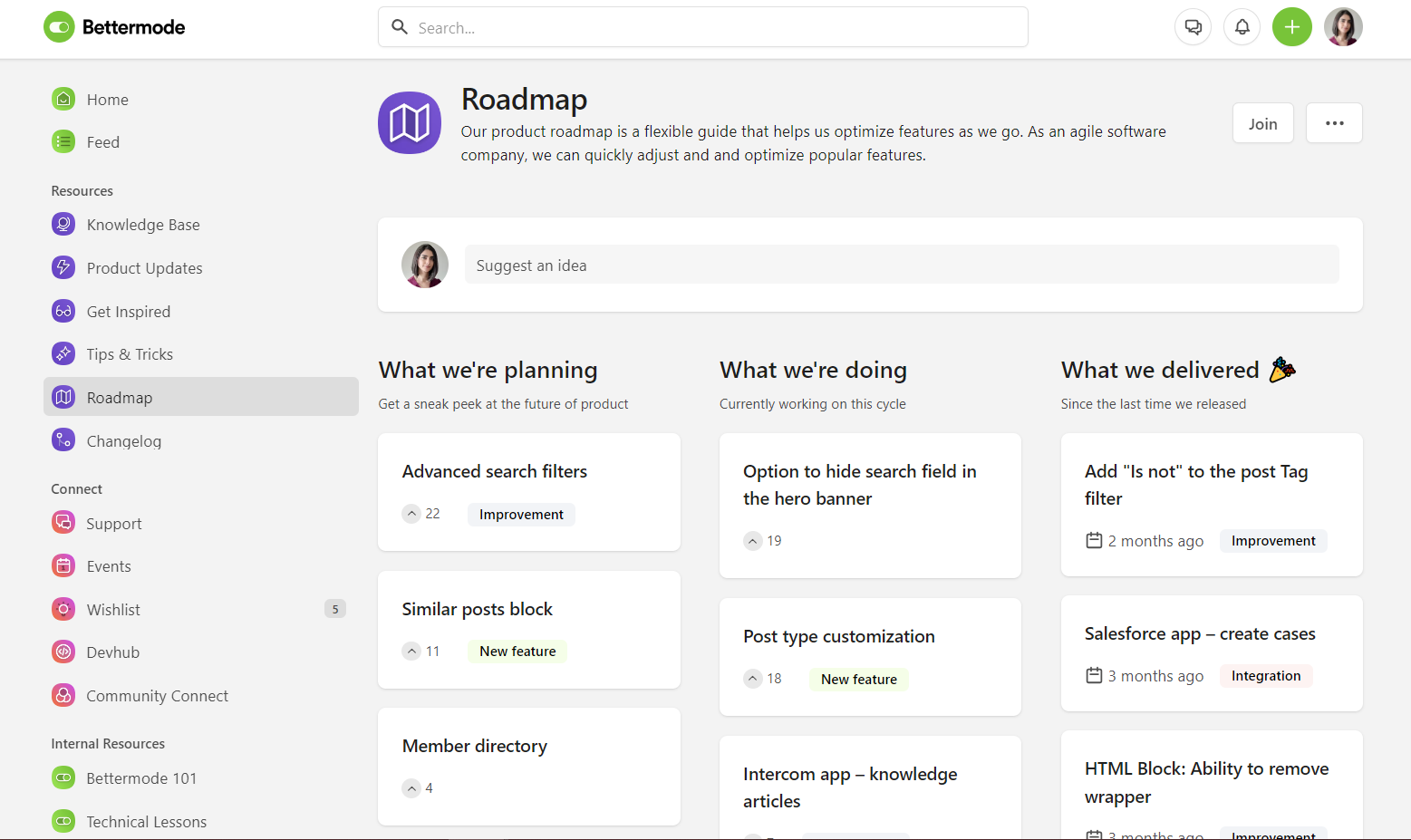
Bettermode's public roadmap is housed within its customer community, demonstrating the capabilities of its own product. The roadmap is neatly categorized into sections such as "What we are planning," "What we're doing," and "What we delivered" and provides users with an immediate sense of the status and progress of various features.
Bettermode also uses labels such as "New Feature," "Improvement," and "Integration." This labeling system helps users quickly understand the nature of the roadmap item, whether it's a new capability being introduced, an enhancement to existing functionalities, or a fix for existing issues.
But what makes Bettermode's roadmap particularly powerful is the user engagement aspect. Users are encouraged to share their ideas and vote or comment on other suggested features. The best ideas that are more popular and align with the product vision will be added to the product roadmap. Users can continue to vote and comment on each item and they can follow them to get notified once the status of those specific features changes.

Bettermode's roadmap is integrated with the other sections of its customer community, such as feature requests, product updates, and changelog. This linkage closes the feedback loop, demonstrates transparency, and exemplifies their commitment to user-centric development.
Buffer

Buffer, a social media management platform, uses a Trello board for its public roadmap portal. The board is broken down into columns representing different stages of the product development process: "Exploring," "In Progress," "Done," and "Leave It For Now."
What's noteworthy is Buffer's level of detail, providing insights into their new ideas, what they're working on, and what's been launched. Their roadmap maintains transparency, encouraging customer feedback and demonstrating their commitment to continuous improvement.
GitHub
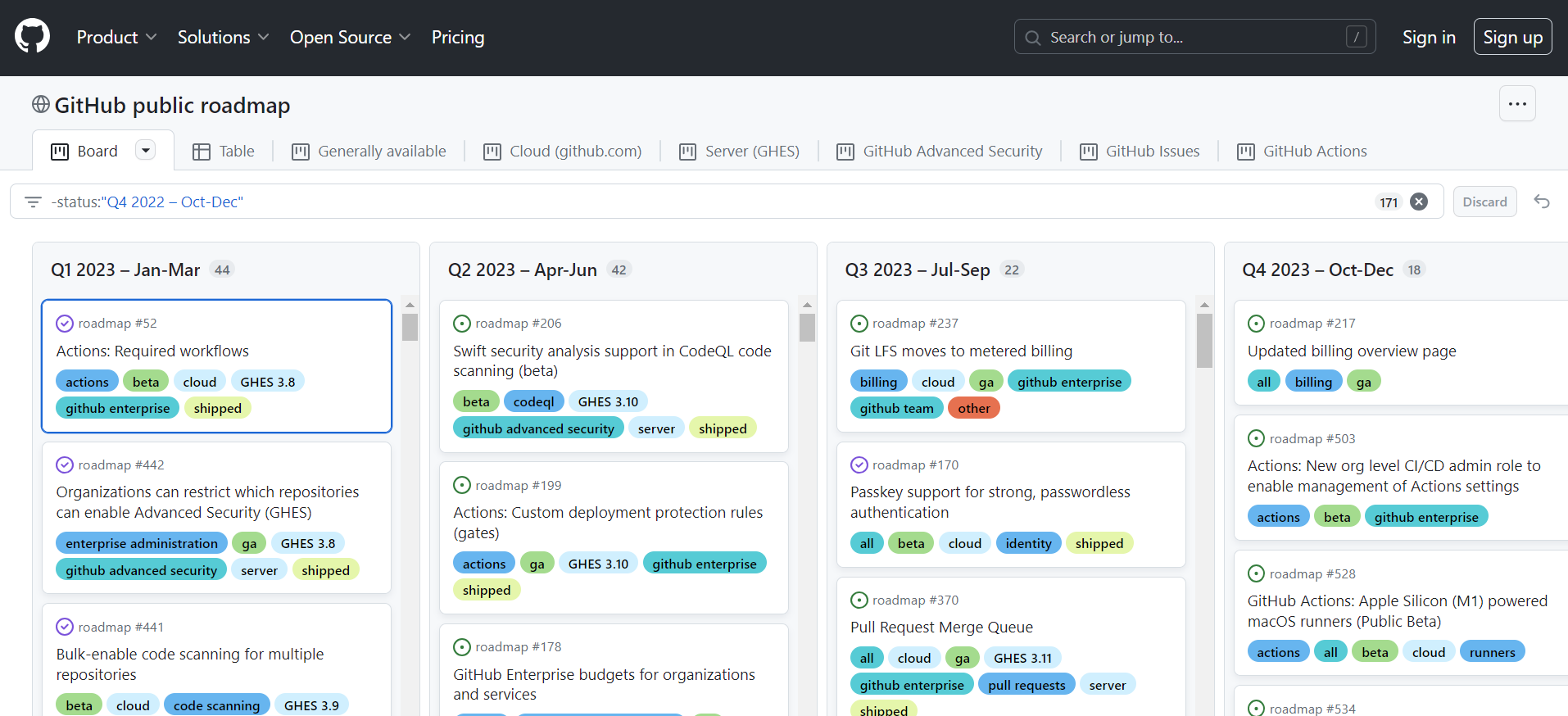
GitHub’s public roadmap, presented via a project board, offers a granular view of their upcoming work. The roadmap is divided into quarters and includes details about what they plan to release. The inclusion of labels like Shipped, In Design, or Beta gives a sense of the project status at a glance. GitHub also uses other labels, such as Billing, Cloud, and GitHub Enterprise to provide more details about each item.
Once a feature is shipped, they add a link to their release notes that provides in-depth information about that specific item and how it works.
Additionally, users have a chance to toggle between Board or Table view, or check all the planned features in one category like Server or Advanced Security. This approach helps them manage stakeholder expectations and demonstrates GitHub's clear, strategic focus.
ClickUp
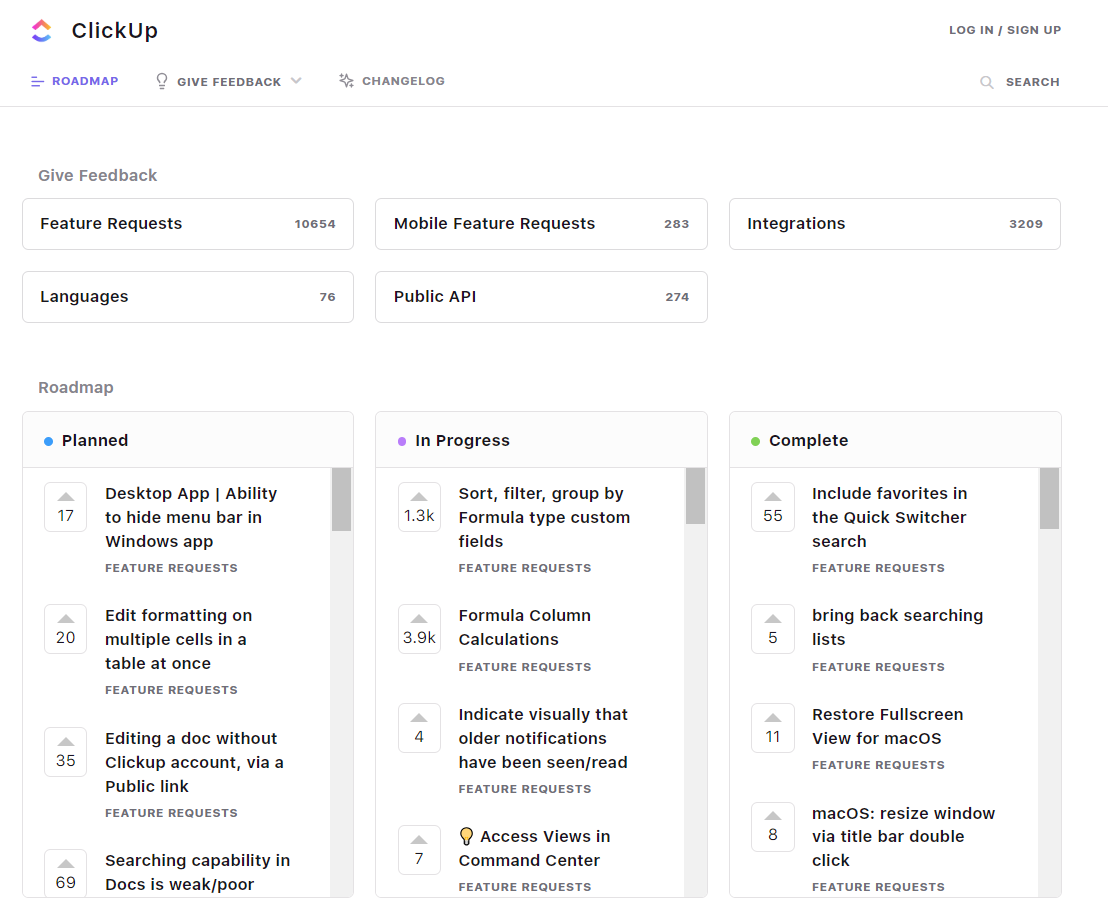
ClickUp, the productivity platform, takes a similar interactive approach to its public roadmap. It's hosted on Canny and the items are categorized into "In Progress," "Planned," and "Completed." ClickUp's roadmap is fully connected to their feedback portal and is created based on requested features. What sets ClickUp apart is the ability for users to comment and vote on features, promoting user engagement.
Productboard
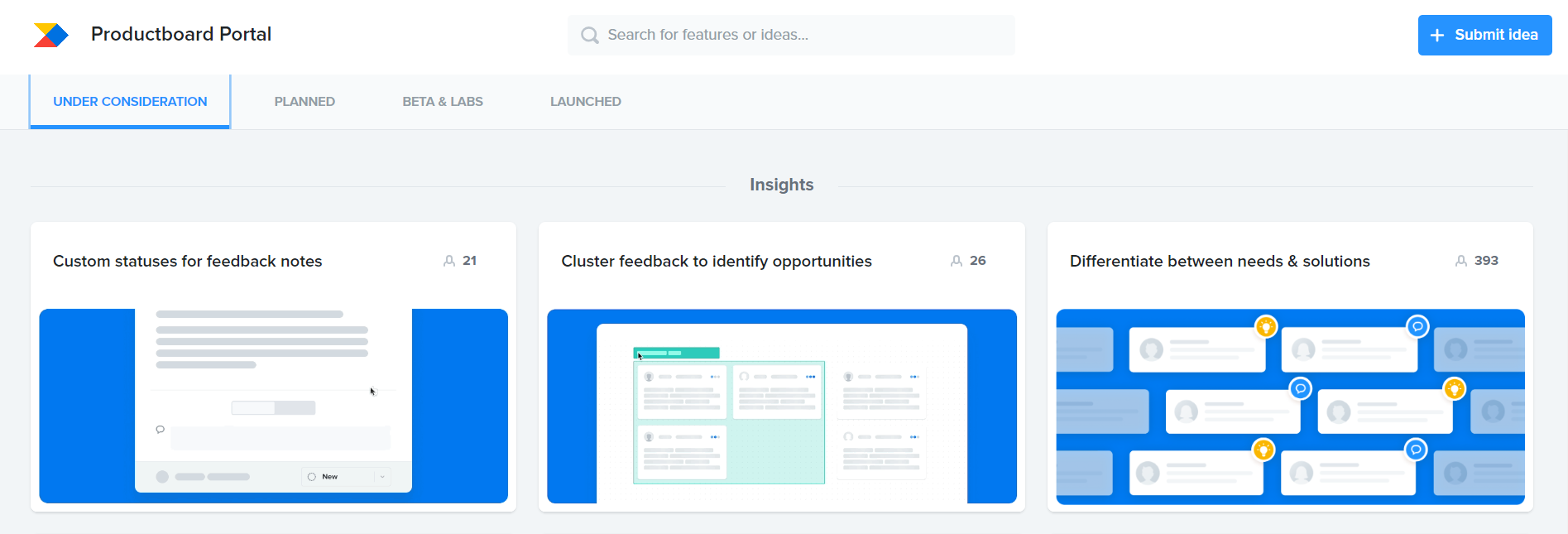
Productboard uses its own product to showcase its public roadmap. They include categories like 'Under consideration', 'Planned, and 'Beta and Labs', giving users a comprehensive view of their plans.
Moreover, users can express interest and provide additional feedback on upcoming features via feedback board, showing Productboard's dedication to user engagement and continuous improvement.
Best tools to build a public product roadmap
Building an effective public product roadmap requires the right tools. Let's explore five of them:
Bettermode

Bettermode is an all-in-one community engagement platform. It unites several customer engagement tools such as Public Roadmap, Changelog, Q&A, Ideas and Help Center into a customer community, and by doing so, it enables businesses to avoid the hassle of managing several platforms and lets them streamline the customer experience.
Bettermode is especially popular among product leaders in the SaaS and technology sectors. Its all-in-one approach allows product teams to connect their ideation and feature request portal, public roadmap, product announcements, and changelog. This enables them to create a closed feedback loop and foster trust with their audience and customer base. What's more - Bettermode's users can build these all with a couple of clicks, using professionally designed templates.

Another key feature of Bettermode is its ability to embed directly into your product and website, making it easier for customers to notice and engage with your public roadmap.
You will also have access to advanced gamification features such as Leaderboard and Badges, which will help you gamify customer participation and encourage them to share their product ideas.
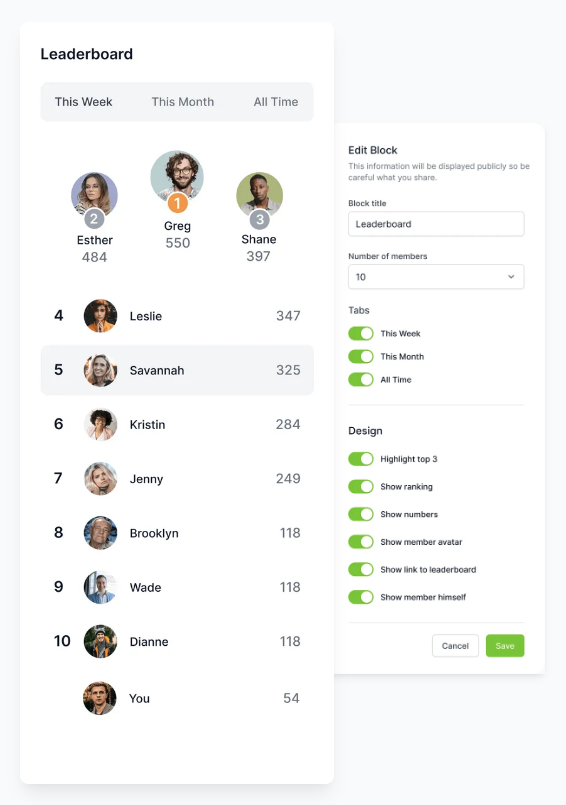
Bettermode is fully customizable, letting you go beyond basic branding. You can select, arrange and configure blocks to build a roadmap that suits your specific needs. You can move it to your custom domain, define categories and labels, create several views, and even make it completely public or only visible to a select group of users (e.g. only your ideal customers). The possibilities are endless.
Con: May not be suitable for brands with a smaller customer base.
Pricing: Bettermode’s pricing starts at $599 per month for its Advanced Plan that provides all you need to build a customer community
Aha!

Aha! is a comprehensive product management tool, but its robust roadmap functionality stands out. It provides various roadmap templates, and with its custom layouts, you can easily tailor your own roadmap to present the information in the most effective way for your audience.
One key feature is its ability to tie your roadmap elements directly to your strategic goals to build alignment and demonstrate the 'why' behind your plans.
Con: Aha! is a complex tool with a steep learning curve, which might be a drawback for new users.
Pricing: Aha! offers several plans, starting from $59 per user per month
Canny.io

Canny.io stands out for its emphasis on user feedback. It enables users to vote on features they're interested in and provides a transparent view of what's being considered, what's being worked on, and what's been launched.
Canny.io is user-friendly, making it a great tool for companies that want to encourage community involvement in their product development.
Con: One downside could be its lack of deeper product management features, as it mainly focuses on ways to collect more feedback and roadmapping.
Pricing: Pricing for Canny.io starts from $50 per month
RoadMunk

RoadMunk is a roadmap tool that offers a variety of visually appealing templates. It supports multiple views, including timeline, swimlane, and table views, allowing you to present your roadmap in the way that best suits your audience.
RoadMunk allows for high-level strategic roadmapping as well as detailed task-based plans, making it versatile for different needs.
Con: Some users may find its interface less intuitive compared to other tools.
Pricing: Starts at $19/month for a single user.
Productboard

Productboard excels in tying user feedback directly to your product roadmap. It is a specialized tool that enables you to capture feedback from multiple sources, prioritize features based on this feedback, and then visualize this on your roadmap.
This tool provides a clear link between customer needs and your product strategy, which is crucial for creating a customer-centric roadmap.
Con: The platform is suitable for complex products with many feature areas, but may require effort to organize the backlog effectively.
Pricing: Plans start at $20/month per user.
Choosing the right tool for your public product roadmap depends on your specific needs, including your product strategy, the level of user engagement you desire, your budget, and your team's familiarity with such tools. Each of the tools above offers unique strengths, so consider these factors carefully when making your own tool choice.
Things to consider when creating a public product roadmap
Creating a public product roadmap requires thoughtful consideration and strategic planning. Here are some key factors to think about during this process:
Determining the level of transparency
The degree of transparency you provide in your public roadmap is a critical decision. Too much detail might lead to overpromising and under-delivering, while too little may result in skepticism or mistrust among your users. Buffer, a social media management platform, strikes a balance by sharing a high-level view of what they are working on, without committing to specific timelines.
The level of transparency should be guided by your company's goals and culture, the nature of your product, and the expectations of your customers. The aim is to be as open as possible about your plans, without creating unrealistic expectations or compromising strategic information about your product or business.
Balancing stakeholder expectations and product realities
A public roadmap should manage stakeholder expectations while remaining true to your product's realities. Stakeholders often have diverse needs and desires, and these must be balanced with what's technically feasible, strategically wise, and financially viable for your product.
This is where the roadmap's flexibility comes in. GitHub, for instance, updates its roadmap based on new insights and feedback, showing an adaptive approach to changing realities and expectations. Being clear that your roadmap is a dynamic document can help manage these expectations.
Tips for maintaining and updating a public product roadmap
Maintaining and updating your public roadmap is crucial to keep your users informed and engaged. Here are some tips for effective maintenance:
- Regularly review and update your roadmap. This can be done monthly, quarterly, or at a cadence that fits your product's development cycle.
- When there are changes, explain the reasons behind them. If a feature is delayed or canceled, let your users know why.
- Keep the lines of communication open. Encourage feedback and suggestions from your users, and respond to their queries or concerns in a timely manner.
- Finally, celebrate your successes. When you release a feature that was on your roadmap, share the news and acknowledge the contribution of user feedback to its development.
Conclusion
A public roadmap is a critical aspect of product management. It fosters trust, encourages community engagement, aligns internal teams, and helps shape a product that meets user needs and expectations. However, crafting and maintaining such a roadmap requires strategic thinking, continuous updating, and open communication. To simplify this process, an all-in-one public roadmap tool, like Bettermode can be instrumental.
Bettermode streamlines the process of sharing your roadmap. It also allows you to collect user feedback and feature requests, and communicate product updates and changelogs. Closing the feedback loop this way cultivates trust and ensures your product meets the needs of your ideal customer. So why wait? Start your journey with Bettermode today and transform the way you manage your product roadmap.
FAQs
Should your roadmap be completely public, or only viewable to users?
The answer depends on various factors, including your company's culture, strategy, and the nature of your own product management team.
A completely public roadmap, visible to everyone including potential and existing customers and competitors, can showcase your commitment to transparency and future plans. It might also act as a competitive advantage, and help you build trust with your potential customers and entice them to become actual users. Companies like Buffer and Trello are good examples of this approach.
On the other hand, making the roadmap only viewable to existing users can foster a sense of exclusivity. It can also prevent competitors from getting a detailed look at your future plans.
In both cases, it's essential to strike a balance between transparency and managing expectations. Ensure that the roadmap doesn't overpromise and underdeliver, and make it clear that it's subject to change based on numerous factors, including feedback and market dynamics. In the end, it's about using the roadmap as a communication tool that works best for your company and your users.






